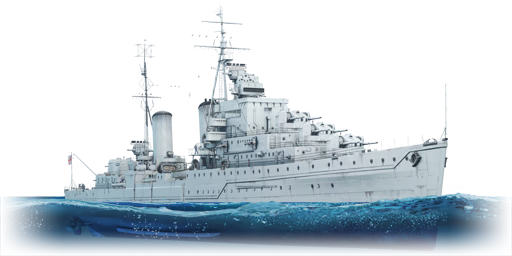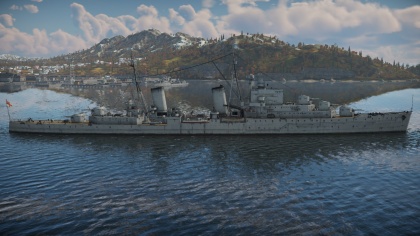Difference between revisions of "HMS Dido"
(Edits.) |
m (con regarding gun dispersion no longer relevant) (Tag: Visual edit) |
||
| Line 54: | Line 54: | ||
'''Cons:''' | '''Cons:''' | ||
| − | |||
* Slow turret rotation | * Slow turret rotation | ||
Revision as of 05:00, 26 September 2019
Contents
Description
The Dido-class, HMS Dido (37), 1941 is a Rank British light cruiser
with a battle rating of (AB), (RB), and (SB). It was introduced in Update 1.85 "Supersonic".
General info
Survivability and armour
As with all British cruisers, the armour is intelligently dispersed between ammunition storage, boiler rooms, and other essential components. The ammunition storage on the Dido is well below the waterline and is protected by 76mm of RHA. The only noticeable weaknesses are the unprotected bridge and meagre turret armour.
Mobility
Write about the ship’s mobility. Evaluate its power and manoeuvrability, rudder rerouting speed, stopping speed at full tilt, with its maximum forward speed and reverse speed.
Armament
Primary armament
The accuracy of the 5.25-inch guns is extremely poor. Against aerial targets, the AA AI armed with HE-VT can bring down a target through sheer volume of fire. Against other light cruisers and even destroyers at normal engagement ranges, the Dido suffers.
Secondary armament
Some ships are fitted with weapons of various calibres. Secondary armament is defined by the weapon chosen with the control Select secondary weapon. Evaluate the secondary armament and give advice on how to use them. Describe the ammunition available for the secondary armament. Provide recommendations on how to use them and which ammunition to choose. Remember that anti-air armament, even heavy calibre weapons, belong in the next section.
If there is no secondary armament, remove this section.
Anti-aircraft armament
The anti-aircraft armament of the Dido is excellent. The dual-purpose primary armaments, 8 x 40 mm guns, and 5 Oerlikons mean that a Dido player can counter planes at all ranges.
Torpedo armament
6 torpedoes, 3 per side. The firing arcs are wide, allowing for ease of fire.
Special armament
Depth charges, mines, rocket launchers and missiles are also effective in skilled hands and can be an unexpected surprise for an opponent. Evaluate the ammunition of this type of armament and rate its performance in combat.
Usage in battles
The Dido boasts good armour and protected ammunition in exchange for aimed fire worse than many 4.3 destroyers. Whether or not this extreme tradeoff is worth it will come down to the individual player. It is not advised to engage other CLs with the Dido. Against DDs, the Dido can take considerably more damage and will usually win.
Pros and cons
Summarize and briefly evaluate the vehicle in terms of its characteristics and combat effectiveness. Mark its pros and cons in the bulleted list. Try not to use more than 6 points for each of the characteristics. Avoid using categorical definitions such as "bad", "good" and the like - they have a substitution in the form of softer "inadequate", "effective".
Pros:
- Good survivability
- Good anti-aircraft potential
- Primary armament dispersed across 6 turrets
Cons:
- Slow turret rotation
History
The Dido-class light cruiser was designed in the 1930s as convoy escorts and destroyer leaders, intended for operations in the Mediterranean. As such, ships of the Dido-class had to be both large enough to operate in rough waters as well as fast and manoeuvrable enough in order to keep up with destroyers, whilst at the same time remaining relatively cheap to produce in large numbers.
HMS Dido, the lead ship of her class, was laid down in October 1937. In July 1939, Dido was completed and commissioned into service a year later. HMS Dido’s early service life was marked with convoy escort duties in the Atlantic, before joining the Eastern Mediterranean Fleet in April 1941.
As part of the Royal Navy’s Mediterranean forces, HMS Dido took part in numerous major operations, including the landings at Sicily and mainland Italy as well as southern France. During her service in the Mediterranean, HMS Dido performed various roles, from doing supply runs over evacuating troops to bombarding shorelines.
By 1944, HMS Dido briefly returned to Great Britain, before being sent off on escort duties as part of the Arctic convoys. In 1945, HMS Dido was sent to Copenhagen, where the warship fired the last naval shot as part of the war in Europe, however not in anger, but in celebration of the surrender of the German Kriegsmarine.
Sometime after the end of WW2, HMS Dido joined the ranks of the Royal Navy reserve fleet, remaining in service for another good decade. In 1957 however, HMS Dido was decommissioned from service and sold for scrap.
- From Devblog
Media
An excellent addition to the article will be video guides, as well as screenshots from the game and photos.
See also
Links to the articles on the War Thunder Wiki that you think will be useful for the reader, for example:
- reference to the series of the ship;
- links to approximate analogues of other nations and research trees.
External links
| Britain light cruisers | |
|---|---|
| Emerald-class | HMS Enterprise |
| Dido-class | HMS Dido |
| Leander-class | HMNZS Leander |
| Arethusa-class | HMS Arethusa |
| Town-class | HMS Belfast · HMS Liverpool · HMS Southampton |
| Tiger-class | HMS Tiger |
| Abdiel-class* | HMS Abdiel |





